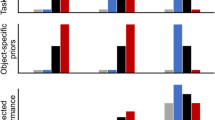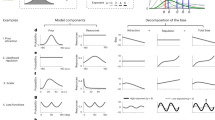Abstract
A VISUAL system makes assumptions in order to interpret visual data. The assumption of 'generic view'1–4 states that the observer is not in a special position relative to the scene. Researchers commonly use a binary decision of generic or accidental view to disqualify scene interpretations that assume accidental viewpoints5–10. Here we show how to use the generic view assumption, and others like it, to quantify the likelihood of a view, adding a new term to the probability of a given image interpretation. The resulting framework better models the visual world and reduces the reliance on other prior assumptions. It may lead to computer vision algorithms of greater power and accuracy, or to better models of human vision. We show applications to the problems of inferring shape, surface reflectance properties, and motion from images.
This is a preview of subscription content, access via your institution
Access options
Subscribe to this journal
Receive 51 print issues and online access
$199.00 per year
only $3.90 per issue
Buy this article
- Purchase on Springer Link
- Instant access to full article PDF
Prices may be subject to local taxes which are calculated during checkout
Similar content being viewed by others
References
Koenderink, J. J. & van Doorn, A. J. Biol. Cybern. 32, 211–216 (1979).
Binford, T. O. Art. Intel. 17, 205–244 (1981).
Biederman, I. Comp. Vis. Graph. Image Proc. 32, 29–73 (1985).
Nakayama, K. & Shimojo, S. Science 257, 1357–1363 (1992).
Lowe, D. G. & Binford, T. O. IEEE Pat. Anal. Mach. Intel. 7, 320–326 (1985).
Malik, J. Intl. J. Comp. Vis. 1, 73–103 (1987).
Richards, W. A., Koenderink, J. J. & Hoffman, D. D. J. Opt. Soc. Am. A. 4, 1168–1175 (1987).
Pentland, A. P. Intl. J. Comp. Vis. 1, 153–162 (1990).
Leclerc, Y. G. & Bobick, A. F. in Proc. IEEE Computer Vision and Pattern Recognition 552–558 (Maui, Hawaii, 1991).
Jepson, A. D. & Richards, W. Spatial Vision in Humans and Robots (eds Harris, L. & Jenkin, M.) (Cambridge Univ. Press, UK, 1992).
Berger, J. O. Statistical Decision Theory and Bayesian Analysis (Springer, New York, 1985).
Tikhonov, A. N. & Arsenin, V. Y. Solutions of III-posed Problems (Winston, Washington DC, 1977).
Poggio, T., Torre, V. & Koch, C. Nature 317, 314–319 (1985).
Terzopoulos, D. IEEE Pat. Anal. Mach. Intell. 8, 413–424 (1986).
Szeliski, R. Bayesian Modeling of Uncertainty in Low-level Vision (Kluwer Academic, Boston, 1989).
Marr, D. C. Vision (Freeman, New York, 1982).
MacKay, D. J. C., Neural Comput. 4, 415–447 (1992).
Weinshall, D., Werman, M. & Tishby, N. Proc. 3rd Eur. Conf. Computer Vision (Springer, Stockholm, 1994).
Horn, B. K. P. & Schunk, B. G. Artif. Intel. 17, 185–203 (1981).
Nakayama, K. & Silverman, G. H. Vision Res. 739–746 (1988).
Cook, R. L. & Torrance, K. E. in SIGGRAPH-81 (Special Interest Group on Computer Graphics Conf. Proc. Assoc. for Computing Machinery, New York, 1981).
Freeman, W. T. in Proc. 4th Intl. Conf. Computer Vision 347–356 (IEEE, Berlin, Germany, 1993).
Bichsel, M. & Pentland, A. P. in Proc. IEEE Computer Vision and Pattern Recognition 459–465 (Champaign, IL, 1992).
Freeman, W. T. Intl. J. Comp. Vis. (in the press).
Author information
Authors and Affiliations
Rights and permissions
About this article
Cite this article
Freeman, W. The generic viewpoint assumption in a framework for visual perception. Nature 368, 542–545 (1994). https://doi.org/10.1038/368542a0
Received:
Accepted:
Issue Date:
DOI: https://doi.org/10.1038/368542a0
This article is cited by
-
Recognizing why vision is inferential
Synthese (2022)
-
The illusion of absence: how a common feature of magic shows can explain a class of road accidents
Cognitive Research: Principles and Implications (2021)
-
Guest Editorial: Generative Adversarial Networks for Computer Vision
International Journal of Computer Vision (2020)
-
Optimality and heuristics in perceptual neuroscience
Nature Neuroscience (2019)
-
Tensors, Differential Geometry and Statistical Shading Analysis
Journal of Mathematical Imaging and Vision (2018)
Comments
By submitting a comment you agree to abide by our Terms and Community Guidelines. If you find something abusive or that does not comply with our terms or guidelines please flag it as inappropriate.



